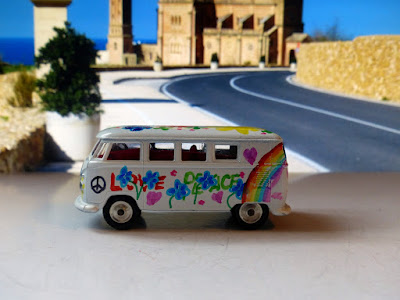It's March and the local toy shop gets an Aston Martin to put on the shelves! #218 was the Aston Martin DB4 and this would be the very first Corgi to have something that opened, with its opening bonnet to reveal a detailed silver painted engine.
It was available in a creamy yellow and various shades of red. I have seen quite a range from brick red to a quite dark red shade but most hover around the brightish red shown here.
The red model will have lemon yellow plastic seats and the yellow one red seats. The early issues have fixed, smooth wheels and many have had a 'wire wheel' sticker attached which makes me wonder whether a set of stickers may not have been included in the box with these at the outset. They are quite different to the 'white wall' trims that were issued in accessory packs and often applied to Thunderbirds, Renaults and Fiats in particular (being the models available that most suited them at the time).
Later the Aston would get fixed shaped wheels (which, as I have written elsewhere, seem quite scarce), then an unattractive cast wheel attempting to resemble wire wheels and finally free-spinning shaped wheels. The bonnet would also change from having an open, quite large vent to a less substantial and closed one. This change is at around the time of the introduction of free-spinning wheels although you may encounter cross-over variations.
The engine element, initially a separate casting also later gets changed to become part of the main body casting and the bonnet hinge mechanism changes at the same time. I don't know when this change occurs but I believe it is fairly evenly distributed amongst the open vent type.
A Competition edition will appear a couple of years later with jewelled headlamps and a new colour scheme (and again two types of bonnet!). As we all know, this casting would also later be used again for the James Bond issues (despite that being a DB5!)
The Aston Martin was a hugely popular model, even before the gold one appears. The number of variations, however, mean that some quite scarce editions can be found at modest prices.
The other items arriving at the shop this month was the ERF Dropside Lorry with a platform trailer and two loads - the planks and cement bags issued in February. (I have revised my text on this!)
Gift Set 11 was allocated to this set which is always in yellow and blue, with an early style towbar on the trailer and smooth wheels on both at the outset. An accessory Pack C was included too.
This is, in fact, the first appearance of the #456 ERF Dropside Lorry, which does not appear individually until November 1961. So it is likely that, if it has smooth wheels it has come from this set and not an individual boxed item.
One source refers to the number 1079 for this set which may have been a reference number in the little red book issued with The Great Book of Corgi - that's where the source copied most of his site information from but I haven't been able to check yet. The same site also says that the trailer should be silver with blue mudguards but as far as I can tell all the sets issued had matching blue load areas and yellow chassis.























